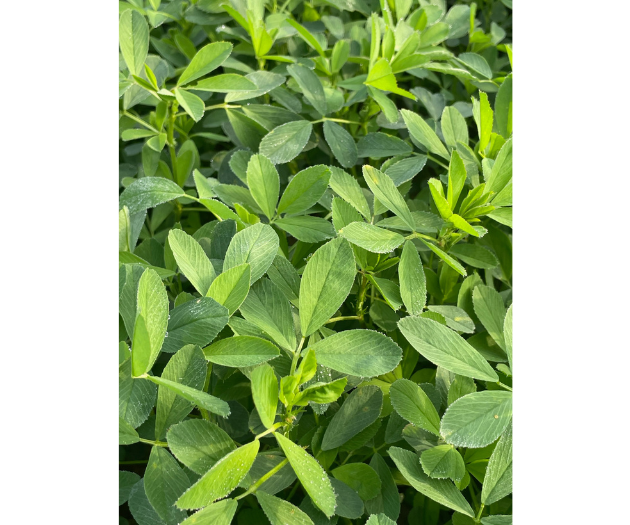


Alfalfa & AlfaGrass
Full Throttle
$280.00
| Package | 50 lb bag |
Need some help? Contact us.
Description
Full Throttle is a full season variety that can push yield in geographies suitable for Fall Dormant 6 alfalfas. Its beautiful bushy plant converts to an excellent quality hay, and its dense stands persist from its full pest resistance package.
Product Guide
Select a topic:
Agronomics
- Fall Dormancy- 6.0
- Winter Survival- 2.0
- Yield Level- 10
- Forage Quality- Excellent
- Root Type- Tap
- DRI- 34/35
- Seeding Rate- 20 lbs/acre
- Recover After Harvest- Average
- Bacterial Wilt- HR
- Fusarium Wilt- HR
- Verticillium Wilt- HR
- Anthracnose (race 1) HR
- Phytophthora Root Rot- HR
- Aphanomyces Root Rot (race 1)- HR
- Aphanomyces Root Rot (race 2)- R
- Stem Nematode- R
- Saline Soil- Tolerant
Planting
- Planting Time:
- Early Spring – after hard freezing conditions have ended
- Late Summer/Early Fall – allow 4-6 weeks of growth before the first hard frost
- Seeding Rate: 15-20 lbs/acre
- Ideal Seed Depth: ½”
- Alfalfa should be drilled into a firm seedbed or broadcasted and packed.
Fertility
- Alfalfa requires 12 lbs of P2O5, 49 lbs of K2O, and 5.4 lbs of S per ton of forage produced.
- Make fertilizer applications based on expected yield and soil fertility levels.
- If soil fertility levels are low, applying 25-30 lbs/acre of nitrogen at planting will help increase stand establishment.
- Do not exceed a total of 10 lbs/acre of N+K if fertilizer is placed in-furrow at planting.
Weed Control
Plant into a clean, weed-free seedbed and consider using the herbicide options below for optimal weed control:
| Timing | Herbicide | Rate | Notes | Weeds Controlled | Control Method |
| Preemergence (seeding) | Butyrac 200 (2,4-DB) | 1-3 qts/a | Apply before weed heights exceed 3″. Minor crop injury may occur. | Broadleaves | Contact |
| Pursuit (Imazethapyr) | 3-6 oz/a | Apply when seedling alfalfa is in the second trifoliate stage or larger | Broadleaves | Contact | |
| Poast (Sethoxydim) | 0.75-2.0 pts/a | Apply before weeds exceed 8″ in height. | Grasses | Contact | |
| Select Max (Clethodim) | 9-16 oz/a | Apply before weeds exceed 8″ in height. | Grasses | Contact | |
| Broclean (Bromoxynil) | 1.0-1.5 pts/a | Apply when alfalfa has a minimum of 4 fully developed trifoliates. Minor crop injury may occur. | Broadleaves | Contact | |
| Postemergence (established) | Butyrac 200 (2,4-DB) | 1-3 qts/a | Apply before weed heights exceed 3″. Minor crop injury may occur | Broadleaves | Contact |
| Pursuit (Imazethapyr) | 3-6 oz/a | Apply immediately after a cutting before excessive regrowth begins. | Broadleaves | Contact | |
| Poast (Sethoxydim) | 0.75-2.0 pts/a | Apply before weeds exceed 8″ in height. | Grasses | Contact | |
| Select Max (Clethodim) | 9-16 oz/a | Apply before weeds exceed 8″ in height. | Grasses | Contact |
Disclaimer: All products and rates were provided by university-based sources and product labels. Always follow label instructions and consult your local chemical dealer and seed dealer before making any applications or planting the seed.
Management
- Nurse Crops: Spring seeded grass can be planted with a small grain nurse crop such as oats, barley, or spring triticale. Use 1/3–1/2 seeding rates of the nurse crop to avoid over competing with new seedlings.
- Example: 1 bushel of oats as a nurse crop vs. a full rate of 3 bushels.
- Nurse crops have little benefit to late summer/early fall seedings and are not recommended.
- Avoid pushing new alfalfa seedings too hard during the establishment year. 1–3 cuttings during the first year is acceptable, depending on growing conditions and region.
- Allow 3–4 weeks from the time of the last cutting until the average first frost date to allow alfalfa to regenerate reserves needed to survive winter and perform well the following year.

